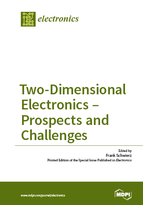Two-Dimensional Electronics - Prospects and Challenges
A special issue of Electronics (ISSN 2079-9292). This special issue belongs to the section "Microelectronics".
Deadline for manuscript submissions: closed (15 September 2015) | Viewed by 116516
Special Issue Editor
Interests: semiconductor device physics and simulation; novel transistor concepts; ultra-high-speed transistors; two-dimensional materials such as graphene, transistion metal dichalcogenides, and others, for electronic applications.
Special Issue Information
Dear Colleagues,
During the past 10 years, two-dimensional materials have found incredible attention in the scientific community. The first two-dimensional material studied in detail was graphene, and many groups explored its potential for electronic applications. Meanwhile, researchers have extended their work to two-dimensional materials beyond graphene. At present, several hundred of these materials are known and part of them is considered to be useful for electronic applications. Rapid progress has been made in research concerning two-dimensional electronics, and a variety of transistors of different two-dimensional materials, including graphene, transition metal dichalcogenides, e.g., MoS2 and WS2, and phosphorene, have been reported. Other areas where two-dimensional materials are considered promising are sensors, transparent electrodes, or displays, to name just a few. This Special Issue of Electronics is devoted to all aspects of two-dimensional materials for electronic applications, including material preparation and analysis, device fabrication and characterization, device physics, modeling and simulation, and circuits. The devices of interest include, but are not limited to transistors (both field-effect transistors and alternative transistor concepts), sensors, optoelectronics devices, MEMS and NEMS, and displays. Scientists and engineers active in the field are invited to submit either review papers or research papers on the exciting field of two-dimensional materials and their application in electronics.
Prof. Dr. Frank Schwierz
Guest Editor
Manuscript Submission Information
Manuscripts should be submitted online at www.mdpi.com by registering and logging in to this website. Once you are registered, click here to go to the submission form. Manuscripts can be submitted until the deadline. All submissions that pass pre-check are peer-reviewed. Accepted papers will be published continuously in the journal (as soon as accepted) and will be listed together on the special issue website. Research articles, review articles as well as short communications are invited. For planned papers, a title and short abstract (about 100 words) can be sent to the Editorial Office for announcement on this website.
Submitted manuscripts should not have been published previously, nor be under consideration for publication elsewhere (except conference proceedings papers). All manuscripts are thoroughly refereed through a single-blind peer-review process. A guide for authors and other relevant information for submission of manuscripts is available on the Instructions for Authors page. Electronics is an international peer-reviewed open access semimonthly journal published by MDPI.
Please visit the Instructions for Authors page before submitting a manuscript. The Article Processing Charge (APC) for publication in this open access journal is 2400 CHF (Swiss Francs). Submitted papers should be well formatted and use good English. Authors may use MDPI's English editing service prior to publication or during author revisions.
Keywords
- two-dimensional semiconductors
- graphene
- transition metal dichalcogenides
- two-dimensional material preparation
- nanoribbons
- mobility
- transistor
- radio frequency
- digital logic
- device physics, modeling, and simulation






